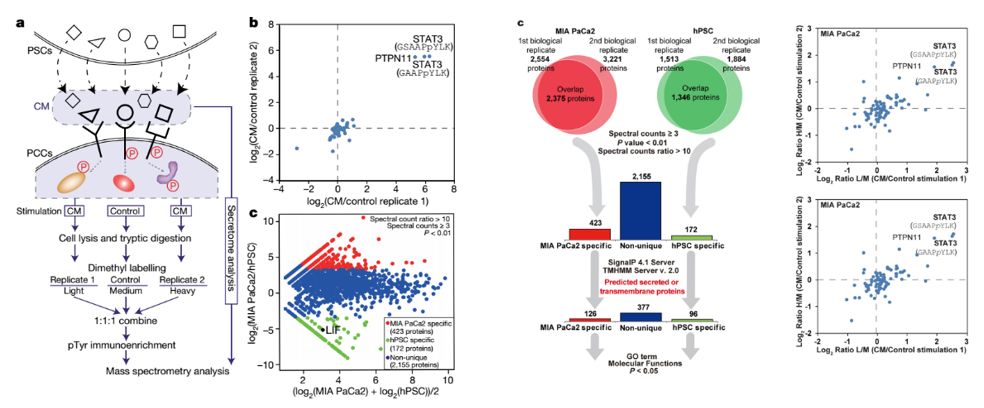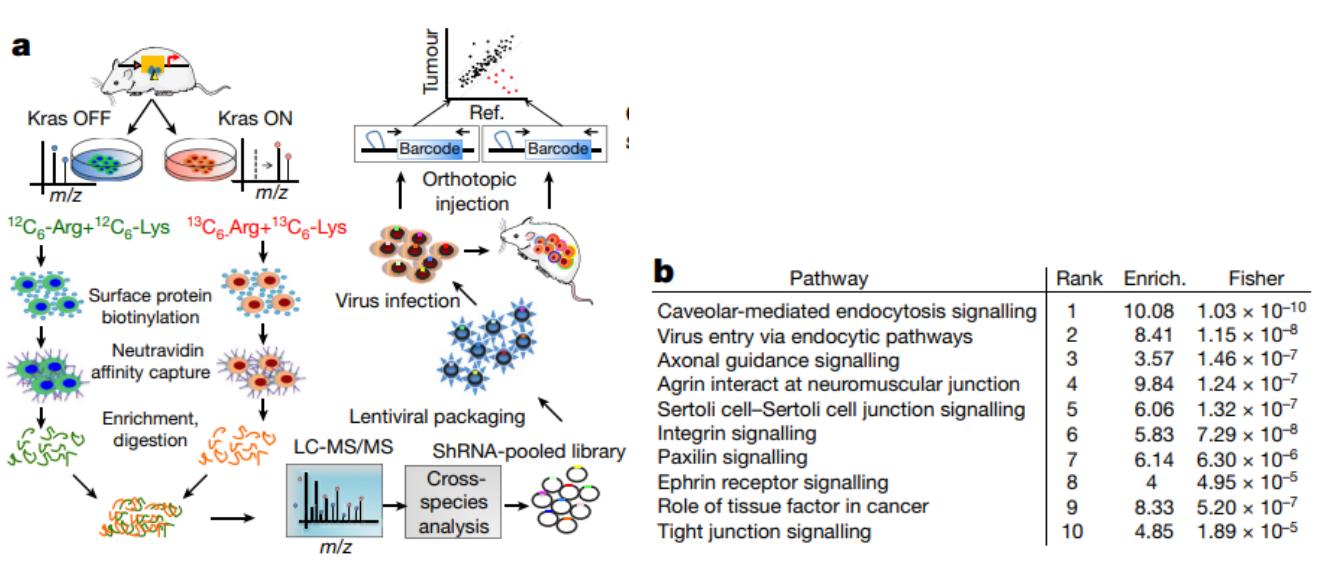Pancreatic cancer is one of the deadliest cancers in the world, with a high incidence and short survival period. The onset of pancreatic cancer is insidious, and early diagnosis is difficult and fast progressing. When detected, it is already in the middle and late stages and most of them have metastasized. Patients who are highly resistant to chemotherapeutic agents and insensitive to radiotherapy lead to very poor treatment outcomes.
Research on highly sensitive biomarkers for early detection and the development of effective targeted drugs will help us to further understand and fight against pancreatic cancer.
Case 1 Pancreatic cancer therapeutic target and diagnostic marker discovery - Leukemia inhibitory factor (LIF)(1)
An integrated proteomics strategy for intercellular signaling in the tumor microenvironment developed, including phosphorylation proteomics, secretion proteomics, and IP-MS protein interactions, revealed that cellular secretions from PSCs stimulate activation of the phosphorylation pathway of transcription factors STATs in PCCs. LIF secreted by PSCs was identified by secretory proteomics as the most critical paracrine cytokine regulating this molecular event in pancreatic cancer cells. The molecular mechanism of intercellular signaling from stellate cells to cancer cells mediated by LIF receptor and GP130, an interacting protein complex with STAT3 present on the surface of pancreatic cancer cells, was identified by IP-LC-MS technique.

Combinatorial MS analyses identified LIF as a key paracrine factor (Shi et al., 2016).
a, Schematic workflow of the MS strategy combining secretome and phosphoproteomic analyses. Matched serum-free medium was used as control stimulation. b, Phosphotyrosine proteomic analysis of CM-stimulated intracellular signalling in PANC1 cells. c, Proteomic analysis and comparison of MIAPaCa2 and hPSC secretome presented as an MA plot. n=2 biological replicates (b,c).
With the help of advanced technology platform of biomass spectrometry and proteomics, the authors developed a new strategy for the functional study of proteins in tumor microenvironment system. They revealed the important function of LIF as an important paracrine cytokine in the molecular mechanism of pancreatic cancer development. Moreover, animal models and clinical data have demonstrated its potential application as an effective therapeutic target and a marker in the clinical diagnosis of pancreatic cancer.
Case 2 KRAS as an energy supply mechanism for pancreatic cancer (2)
Pancreatic ductal adenocarcinoma (PDAC) is a highly malignant and difficult to diagnose and treat GI malignancy. 90% of pancreatic ductal carcinomas have a Kras mutation. This mutation activates macrophages in the tumor microenvironment and promotes endocytosis of macrophages through as yet unclear mechanisms.
In order to accurately find the metabolism of pancreatic ductal adenocarcinoma, Giulio Draetta's team launched a challenge. They constructed KRAS*-ON and KRAS*-OFF models and extensively screened cell surface proteins related to the study of KRAS through proteomics techniques with the aim of finding new targets for the treatment of pancreatic cancer.
To explore the changes in cell surface protein expression brought about by Kras signaling, the research team compared KRAS*-OFF with KRAS*-ON differences using SILAC quantitative proteomic technology. This analysis yielded 221 differentially expressed proteins, of which 196 proteins were up-regulated and 25 were down-regulated. Pathway analysis revealed that many of the upregulated proteins are involved in biological processes associated with PDAC activation, including axon-directed signaling pathways. This result supports the idea that KRAS* is a major driver of molecular reprogramming in PDAC. Subsequent screening and functional validation of key proteins revealed that SDC1 on the surface of iKras* tumor cells is critical for disease progression. It provides energy for tumor cell growth by regulating macropinocytosis.

Functional surfaceome analysis identifies SDC1 as a KRAS*-dependent surface protein that is important for tumour maintenance (Yao et al., 2019).
a, Experimental design for the functional surfaceome analysis. b, Top-ten canonical signalling pathways identified with IPA analysis of differentially expressed surface proteins upon KRAS* activation.
This study extensively examined changes in cell surface proteins due to altered Kras status using proteomics techniques. A screen among differential proteins was performed to obtain proteins of interest and extensive functional validation was performed. A mechanistic link was eventually established between KRAS* signaling and target molecules driving nutrient recycling pathways in PDAC. It also provides a strategy for subsequent tumor studies to find cancer-specific weaknesses by analyzing surface protein expression differences.
Resources
- Shi, Y., Gao, W., et al. (2019). Targeting LIF-mediated paracrine interaction for pancreatic cancer therapy and monitoring. Nature, 569(7754), 131-135.
- Yao, W., Rose, J. L., et al. (2019). Syndecan 1 is a critical mediator of macropinocytosis in pancreatic cancer. Nature, 568(7752), 410-414.










